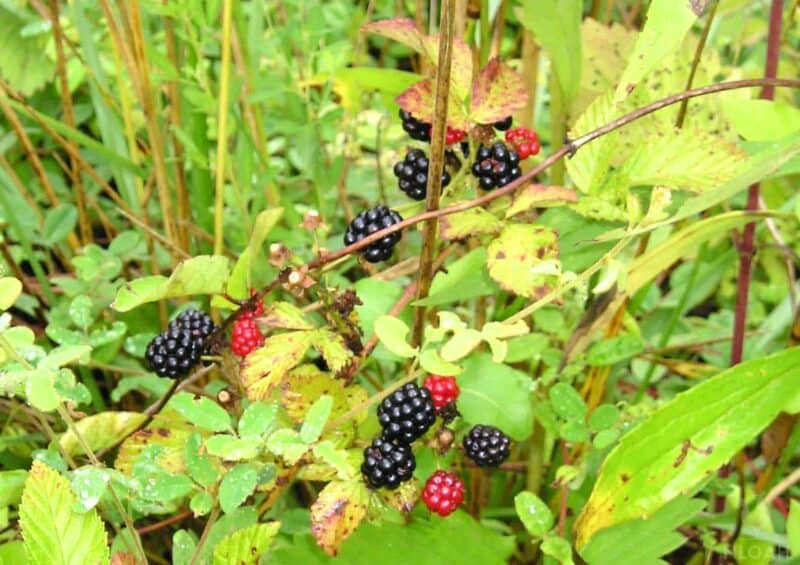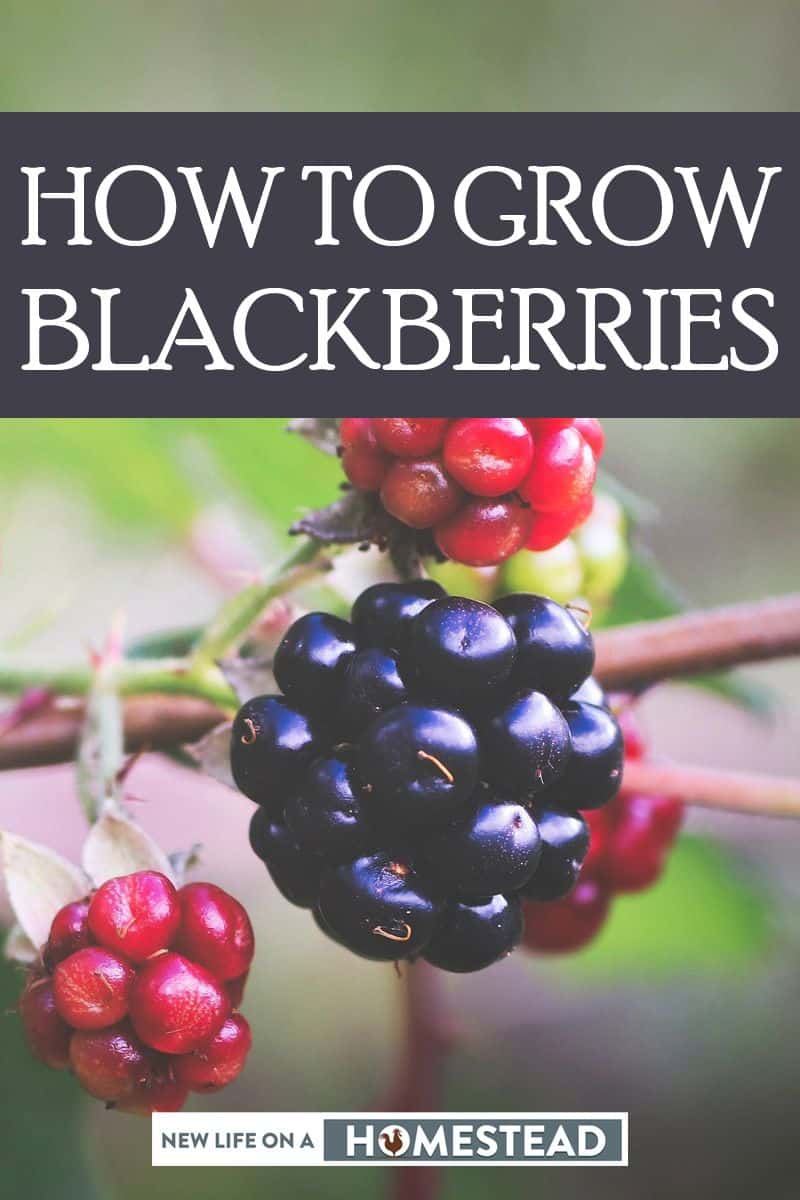Have you been wanting to grow fruit on your homestead – but put it off because you thought it was too big of a task for you to handle? Think again.
Blackberries are some of the easiest plants you can grow on your homestead or in your backyard, and they’re also some of the most productive. Once you get these plants going, you’ll have an abundant harvest that will give you more berries than you know what to do with!

Here are some tips for growing this plump, tasty fruit at home.
Why You Should Grow Blackberries
Their delicious taste aside, there are countless reasons why you should grow blackberries at home. Not only are they easy to grow, but store-bought blackberries tend to be very expensive and are often treated with chemicals like pesticides and herbicides.
You can grow your own tantalizing, sweet blackberries at home for a fraction of the cost of what you would pay at the store – and in an organic way, to boot. Tart blackberries offer some impressive health benefits, too, possessing large quantities of:
- Vitamin C
- Fiber
- Vitamin K
- Manganese
- Antioxidants
- Anti-Inflammatory compounds
Blackberries are low in fat and high in fiber. And compared to many other fruits, they’re also low in carbohydrates, a great feature if you are watching your weight. There’s plenty of evidence suggesting that eating blackberries on a regular basis can:
- Improve mental functioning
- Prevent osteoporosis
- Reduce epileptic seizures
- Manage blood sugar
- Prevent bruising
- Reduce cholesterol
- Help you lose weight
- Promote good digestion
Interestingly, blackberries are also quite high in ellagic acid, an antioxidant that is also found in raspberries and strawberries.
Types of Blackberry Plants
Essentially, there are three types of blackberries: erect thorny blackberries, trailing thornless blackberries, and thornless blackberries.
Erect blackberries are free-standing, self-supporting bushes, while trailing blackberries produce long canes that must have a trellis for support.
All varieties of blackberries are perennials, meaning the root will come back every year. However, the portion of the plant that sit above the soil are biennial, producing vegetation for a year, bearing fruit the next year, and then dying.
While this may sound defeatist, the plant also sends up new canes each year to replace those that died. As long as you prune regularly, you will have a successful harvest for years to come.
Here are some of the most popular varieties of blackberries you can grow.
Erect Thornless
- Navaho
- Arapaho
- Chester
- Apache
- Ouachita
Erect Thorny
- Cherokee
- Brazos
- Shawnee
- Cheyenne
- Darrow
- Rosborough
Semi-Erect Thornless
- Black Satin
- Triple Crown
Trailing
- Marion
- Olallie
- Logan
- Tayberry
- Boysen
Ideal Planting Conditions for Blackberries
Blackberries need to be grown in full sun for good berry production. Soil should have good drainage and contain plenty of organic matter. Avoid planting your blackberries too close to wild blackberries. These can carry viruses.
If you are planting a variety of blackberry that requires a trellis, do this before planting. These are simple to build and are inexpensive to construct. A simple trellis might involve just a couple of pressure-treated posts that are sunk three feet deep in the ground.
Although blackberries don’t need to be trained to a trellis in the first year of growth, it will benefit you to build one ahead of time so that it is already in place once your plants have developed.
How to Plant Blackberries
You can purchase blackberry canes from most nurseries. When you buy them, the canes of the shrub will have been mostly cut back at the nursery already. You will likely not have a crop during the plant’s first year of growth, as your plant will instead be using all of its energy to develop strong roots.
As blackberries are perennials, it will serve you well to prepare the soil before you plant. This way, your work will be taken care of down the road. Blackberries produce best when grown in well-draining, fertile soil.
Consider adding about two inches of compost to the soil to help raise the nutrient content of the area. You should also keep in mind that although blackberries prefer slightly acidic soil (with a pH between 5.5 and 7.0), you can easily add some lime to raise the pH or sulfur to lower it.
Plants should be spaced about five to six feet apart, but there is some variation in this. Trailing varieties need more space, while erect cultivars can get by with as little as three feet between them.
You should plant your canes in a shallow format – place them only about an inch deeper than they were grown in the nursery.
When you plant, dig a hole that is wide enough to accommodate all the roots without crowding them. Place the shrub in the hole, arranging it so that the crown is level with the surroundings oi.
Fill the hole about three-quarters of the way with soil. Then, pour a gallon of water into the soil to get rid of air pockets. Continue filling in the rest of the soil, and then water thoroughly once again.
You can plant in the late fall, but this is not recommended if you live in a colder growing zone. Low temperatures can kill some hybrids of blackberries. However, in most cases, you can also plant blackberries in the early spring.
Taking Care of Your Blackberry Plants
Blackberry plants are self-fertile, which means you do not need to keep multiple plants in order to have good fruit production. That being said, blackberry plants do have other growing conditions that they need to have met in order to be healthy and productive.
You should maintain a thick layer of mulch around your plants at all times to help conserve moisture. This will also help to control weeds.
Provide your plant with lots of water, particularly during the initial stages of growing and while the plants are setting and ripening fruit. At least an inch of water per week is needed – sometimes more during hot weather.
You should also fertilize your blackberries in early spring. Use an all-purpose fertilizer like a 16-16-8, or add a layer of organic compost for best results.
If you are growing trailing blackberries, you will need to erect a support system or trellis. The easiest way to do this is by using a two-wire system. This requires you to run a top wire about six feet above the ground.
You will run another wire about a foot and a half below this. Following the first year of growth, the plant will produce fruiting floricanes along those wires. You can train the canes to grow all in one direction.
Pests and Diseases
Blackberry plants aren’t prone to many diseases, but you may notice that they attract raspberry borers or fruit worms. These can be removed by manual control, but it will require you to check the plants every day for signs of infestation or egg laying.
The diseases to which blackberry plants are vulnerable include gray mold and some viruses. The most common virus is Raspberry Bushy Dwarf virus. This causes the leaves to develop a bright yellow hue, and they may also begin to look bleached as the summer carries on.
Crown gall is another common disease. This creates stunted and slow-growing leaves. You may also notice that there is decreased fruit production. Crown gall is more common in hot weather but you will need to check your roots for tumors to be sure it is this disease/
Aphids can also afflict your blackberry plants. These suck out plant juices and cause the leaves of your plant to thicken, curl, yellow, and eventually die. You can use an insecticidal spray to get rid of aphids, or you can manually remove them upon daily inspection.
Pruning Blackberries
You may also need to prune your blackberry plants each year. This sounds complicated, but the idea is to basically remove old canes that have already born fruit. This will allow the new ones to take their place.
The pruning process will be a little bit different depending on the types of blackberries you are growing. Trailing blackberries will need to have the old floricanes removed to the ground ft the harvest period.
It’s best to wait until the canes have died back to allow them to cycle some nutrients back into the roots of the plant. Once you remove the old cane, you can train new ones up on the wires.
If you are pruning erect blackberries, you should prune these in the summer. To do this, remove the top inch or two of new primocanes when they are about four feet tall.
When you do this, the canes will branch out to increase the following year’s yields. You may need to prune several times to tip each cane.
Transplanting
Check out this separate article we have on transplanting blackberry bushes.
Blackberry Companion Plants
Many people use blackberries as understory plants for taller trees and shrubs.
You might want to plant your blackberries under Pacific madrone or white oak trees, for example, because they both store moisture in their canopies and shed nutrients for the blackberry in the mulch their leaves produce. You could also try a dwarf tree like a cherry, pear, or almond tree.
You can also grow plants that will grow to a similar height as your blackberries. You might want to consider shade-tolerant options like hazelnuts, serviceberries, or thimbleberries. These will give you a harvest even when your blackberries are not producing.
Taller herbs can also be a good choice. These will encourage pollinators to visit your blackberries and will also ward off damaging pests. You might want to consider rose bushes or bee balm, borage, and hyssop.
Ground covers can also be a good choice, as they’ll control weeds and repel insects. Good choices include peas, beans, strawberries, or chives.

Harvesting Blackberries
Harvesting blackberries is easy – wait until the berries have turned completely black in order to harvest them. The berries on your plant will likely be at different stages of maturity, so you will need to keep an eye on them to harvest sporadically.
Remember, the year that you plant your berries, you will not get a harvest. You will need to wait until the second year. Most blackberries are ready for a harvest between July and August, but some may be ready earlier.
Check your specific plant type to be sure – early-season varieties are usually ready in July or August, while late-season types will take more time to mature.
You’ll know your plants are nearing readiness when they set tiny red drupes on the flowers. This usually occurs about two to three weeks before the harvest. The berries are ready to harvest when they are totally black but still firm.
To harvest berries, pull gently from the plant. Don’t yank too hard, as this can damage the plant. If you accidentally harvest an unripe berry, discard it – unripe berries do not ripen off the plant.
Once your berries start to ripen on the plant, you will need to harvest them regularly – typically every few days.
Try to harvest blackberries during the cooler portions of the day. Place the berries in the shade and get them in the refrigerator as quickly as possible. They are very perishable and last only a few days after harvest even when refrigerated.
Preserving Blackberries
You should try to have a plan in place for using or preserving your blackberries as soon as you harvest them, because they begin to spoil rapidly after harvest. Before preserving them, check them for any soft or moldy spots and discard any unpleasant-looking fruits.
After harvesting and cleaning your fruit, you have several choices. Freezing your blackberries is perhaps one of the easiest ways to store them, but you need to be careful in doing this.
If you put them in a freezer bag while they are still thawed, this will result in a frozen, mushy mess when you remove them from your cooler.
An alternative would be to freeze them on a cooking sheet covered in waxed paper. Place the cookie sheet in the freezer and once the berries are frozen, you can transfer them to freezer bags for easier storage. You can also freeze pureed buries if you so choose.
Many people choose to make blackberry jam, which is easy to do with a water bath canner, some pectin, and lots of sugar. Blackberry jelly is another favorite. This will allow you to eat tasty blackberries for months on end.
You can also make blackberry syrup, which requires boiling blackberries, water, and syrup. This can also be canned to be eaten on top of pancakes, breads, or even by the spoonful.
So what are you waiting for? There are no more excuses! Get out there and plant a few blackberry plants today. Be sure to leave a comment with your questions or tips for growing these delicious fruits, and to pin this article for alter on your favorite Pinterest board.


Rebekah is a high-school English teacher n New York, where she lives on a 22 acre homestead. She raises and grows chickens, bees, and veggies such as zucchini (among other things).


When we bought our land, it was over-run with wild blackberry vines. It was wonderful. We still have a few, but not as many as we had, and not in the same place. It’s wonderful.
Lots of great information here! We have wild blackberries growing on our farm. Did you know that the first picture on your article is of black raspberries?
I love blackberries! We had to move from our farm in July ’19 and I had to leave my beloved blackberries behind. The one was 14+ years old, I usually forgot to prune it in time, and that lovely thing produced incredible amounts for me every year after it matured!
Now I’m in a townhouse in a quiet, small development in a somewhat rural setting, so am planning out raised beds along our privacy fence as well as next to our large garden shed. I’m thankful for finding your article as it helped me plan out varities as I’d forgotten what mine were I’d had them so long, but I do by far prefer the thornless erect.